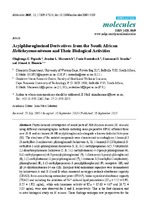| dc.description.abstract | Abstract: Phytochemical investigation of aerial parts of Helichrysum niveum (H. niveum)
using different chromatographic methods including semi-preparative HPLC afforded three
new (1–3) and six known (4–10) acylphloroglucinols alongside a known dialcohol triterpene
(11). The structures of the isolated compounds were characterized accordingly as 1-benzoyl-3
(3-methylbut-2-enylacetate)-phloroglucinol (helinivene A, 1), 1-benzoyl-3 (2S-hydroxyl-3-
methylbut-3-enyl)-phloroglucinol (helinivene B, 2), 8- (2-methylpropanone)-3S, 5, 7-trihydroxyl-
2,2-dimethoxychromane (helinivene C, 3), 1-(2-methylbutanone)-4-O-prenyl-phloroglucinol (4),
1-(2-methylpropanone)-4-O-prennyl-phloroglucinol (5), 1-(butanone)-3-prenyl-phloroglucinol
(6), 1- (2-methylbutanone)-3-prenyl-phloroglucinol (7), 1-butanone-3- (3-methylbut-2-enylacetate)-
phloroglucinol (8), 1-(2-methylpropanone)-3-prenylphloroglucinol (9), caespitate (10), and
3β-24-dihydroxyterexer-14-ene (11). Excellent total antioxidant capacities were demonstrated
by helinivenes A and B (1 and 2) when measured as oxygen radicals absorbance capacity
(ORAC), ferric-ion reducing antioxidant power (FRAP), trolox equivalent absorbance capacity
(TEAC) and including the inhibition of Fe2+-induced lipid peroxidation (IC50 = 5.12 ± 0.90;
3.55 ± 1.92) µg/mL, while anti-tyrosinase activity at IC50 = 35.63 ± 4.67 and 26.72 ±
5.05 µg/mL were also observed for 1 and 2, respectively. This is the first chemical and
in vitro biological study on H. niveum. These findings underpin new perspectives for the | en_US |

